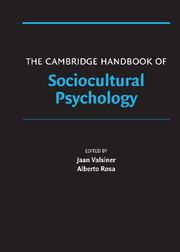Crossref Citations
This Book has been
cited by the following publications. This list is generated based on data provided by Crossref.
Rosa, Alberto
2001.
The Cambridge Handbook of Sociocultural Psychology.
p.
205.
Moghaddam, Fathali M.
2009.
Commentary: Omniculturalism: Policy Solutions to Fundamentalism in the Era of Fractured Globalization.
Culture & Psychology,
Vol. 15,
Issue. 3,
p.
337.
Tileagă, Cristian
2009.
The social organization of representations of history: The textual accomplishment of coming to terms with the past.
British Journal of Social Psychology,
Vol. 48,
Issue. 2,
p.
337.
Valsiner, Jaan
2009.
Integrating Psychology within the Globalizing World: A Requiem to the Post-Modernist Experiment with Wissenschaft.
Integrative Psychological and Behavioral Science,
Vol. 43,
Issue. 1,
p.
1.
Salvatore, Sergio
Davanzati, Guglielmo Forges
Potì, Silvia
and
Ruggieri, Ruggero
2009.
Mainstream Economics and Sense-Making.
Integrative Psychological and Behavioral Science,
Vol. 43,
Issue. 2,
p.
158.
Moghaddam, Fathali M.
2010.
Commentary: Intersubjectivity, interobjectivity, and the embryonic fallacy in developmental science.
Culture & Psychology,
Vol. 16,
Issue. 4,
p.
465.
Esteban, Moisès
and
Vila, Ignasi
2010.
Modelos culturales y retratos de identidad. Un estudio empírico con jóvenes de distintos contextos sociodemográficos.
Estudios de Psicología,
Vol. 31,
Issue. 2,
p.
173.
Martínez-Guerrero, Luis
2010.
¿Qué aporta la psicología al marco general de las ciencias de la religión?.
Estudios de Psicología,
Vol. 31,
Issue. 2,
p.
205.
Sammut, Gordon
Daanen, Paul
and
Sartawi, Mohammad
2010.
Interobjectivity: Representations and artefacts in Cultural Psychology.
Culture & Psychology,
Vol. 16,
Issue. 4,
p.
451.
Branco, Angela
and
Valsiner, Jaan
2010.
Towards cultural psychology of affective processes: Semiotic regulation of dynamic fields.
Estudios de Psicología,
Vol. 31,
Issue. 3,
p.
243.
Misra, Girishwar
and
Pandey, Janak
2011.
IAAP Handbook of Applied Psychology.
p.
588.
Grossen, Michèle
and
Salazar Orvig, Anne
2011.
Dialogism and dialogicality in the study of the self.
Culture & Psychology,
Vol. 17,
Issue. 4,
p.
491.
Talamo, Alessandra
and
Pozzi, Simone
2011.
The tension between dialogicality and interobjectivity in cooperative activities.
Culture & Psychology,
Vol. 17,
Issue. 3,
p.
302.
Sofaer, Joanna
2011.
Social Bioarchaeology.
p.
283.
Jesus, Paulo
2011.
Meaning-creation, selfhood, and religion: From religious metanarratives to spiritual self-narratives.
Estudios de Psicología,
Vol. 32,
Issue. 1,
p.
131.
Swami, Viren
Chamorro-Premuzic, Tomas
Mastor, Khairul
Hazwani Siran, Fatin
Said, Mohammad Mohsein Mohammad
Jaafar, Jas
Sinniah, Dhachayani
and
Pillai, Subash K.
2011.
Celebrity Worship Among University Students in Malaysia.
European Psychologist,
Vol. 16,
Issue. 4,
p.
334.
Kullasepp, Katrin
2011.
Creating My Own Way of Being a Psychologist.
The Japanese Journal of Personality,
Vol. 19,
Issue. 3,
p.
217.
Belzen, Jacob A.
2011.
La perspectiva cultural en la psicología de la religión: estudio sobre la espiritualidad “bevindelijke” a modo de ejemplo.
Estudios de Psicología,
Vol. 32,
Issue. 1,
p.
103.
Smith, Gareth Dylan
2011.
Book review: M. S. Barrett (Ed.), A Cultural Psychology of Music Education. Oxford: Oxford University Press, 2011. ISBN 9780199214389.
Psychology of Music,
Vol. 39,
Issue. 3,
p.
389.
Martínez-Guerrero, Luis
2011.
Las variedades de la psicología de la religión: explorando las diferentes formas de construir el objeto de estudio.
Estudios de Psicología,
Vol. 32,
Issue. 1,
p.
51.



